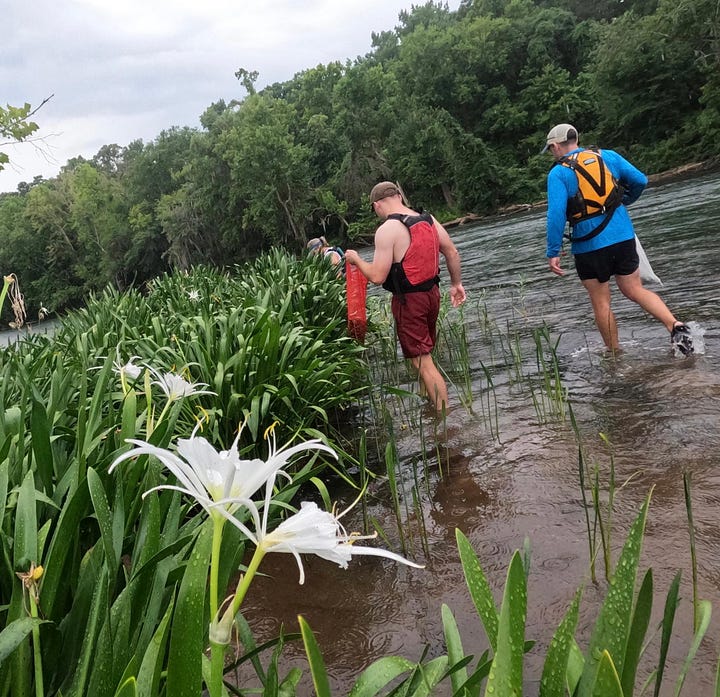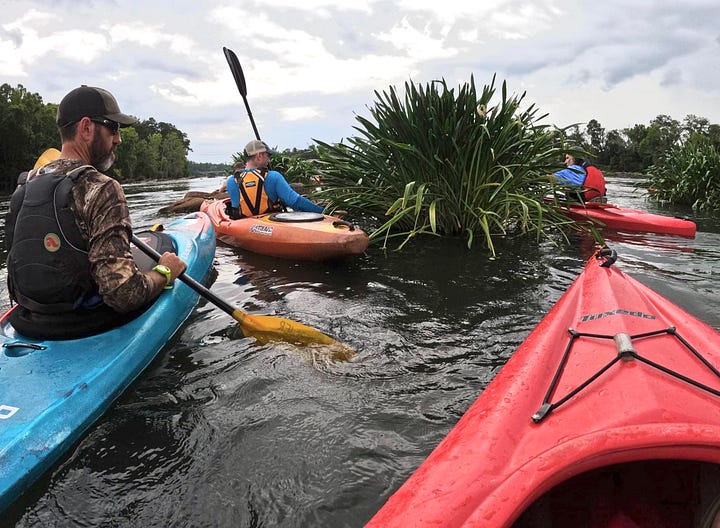Projected onto the screen behind the speaker, a little girl in a yellow dress stands knee-deep in muddy water, with Larry’s favorite lily towering over her. She holds a Cabbage Patch Kid, the trendy doll that came and went quickly in the ‘80s. Her blond hair twists. She is not smiling.
Dr. Larry Davenport, a botanist, has focused on one plant since the 1980s. He has made countless children, grandchildren, and random people stand by his lilies— for scale. Before I came to this conference, I worried that it could be deadly boring. But Larry set the tone when he said, “Look, I’m here and you are here because we do not want Cahaba Lilies to go the way of the Cabbage Patch Kids—antiques lost to all but the memory of a few old botanists!”
Larry works in Alabama and has made great strides in understanding and protecting these threatened lilies. He also knows the exact causes of their slow demise. The question of the day is, “What can we do to bolster populations?” The question that I leave the conference with is this: Why bolster populations when we know what’s causing the decline? If we really care, we’ll address those issues.
These lilies have an odd and limited distribution across the fall line, which is the geographical delineation between the Piedmont and the Coast Plains. Where those two land types meet in Alabama, Georgia, and South Carolina, boulders line the shallow rivers. Only in these shallows, only in this deep South ecosystem, do Cahaba Lilies, also known as Rocky Shoal Lilies, thrive.
But there is a gap. Look at the map, and you’ll notice lots of lilies in Alabama and lots in South Carolina. But there’s a gap in Georgia. No worries, a plant geek like Larry has a few theories about the mysterious absence in the Peach State.
Genetically, the distant populations are very different. But they can be traced back to a time 8 million years ago when they were the same—that’s their divergent point. At that same time, there was a huge saltwater strait between what’s now Georgia and Florida. Remember, all this state-line business is based on warring Europeans.
State lines have nothing at all to do with plants, animals, ecosystems, or native plant ranges. On the map, you see where the populations are, and if you stood in any of those spots, you’d see they all are the same: shallow water with rocks. “That’s what is what is important here,” said geoscientist Dr. Scott H. Markwith. The geography and the water connection that was there, the Suwanne Straight, connected these rivers 8 million years ago.
And what’s in rivers? Fish that eat seeds. And fish that carry plant seeds for a few days, then poop them. Here’s a map
Larry, an accomplished scientist, does what any responsible speaker addressing biology ought to do. He points out that we don’t know this. There are other possibilities: birds or mammals that ate seeds in one place migrated and then dropped seeds when it was time to poop. Or maybe there were populations of Spider Lilies that were obliterated before anyone noted their existence. We don’t know.
At the other end of the Rocky Shoals range, in Columbia, South Carolina, Andy Cabe, Director of Riverbanks Botanical Garden, says, “We’ve been involved in conservation efforts and seed collecting for over 20 years. Soon, we’ll kayak out, collect seeds, grow them out in our greenhouse facility, then reintroduce them to the wild when they are a year old.” Andy spear-headed the in-the-wild conservation effort, but he’s done lots more. Realizing that this species will not thrive in gardens and landscapes, he’s hybridized it with similar species, creating breathtaking garden plants. That sort of work reduces the desire for folks to steal seeds from the wild — it helps home gardeners connect, love, and share stories about rare plants.
Right smack in the middle, on the Savannah River between Carolina and Georgia, the Porter Fleming Foundation and Phinizy Swamp Center for Water Resources have sponsored this conference and some great research work. After Dr. Davenport presented, three different speakers (Donna Wear, Augusta University; Althea Hagan, Clemson; and Owen Navarre, Phinizy Center) discussed their reintroduction projects. As hard as they try, as much work as they do, the success rate is about 12%.


Riverbanks Botanical Garden and the South Carolina Department of Natural Resources, with permits, collect seeds and grow them out to be replanted in the river.
All of these people, doing such admirable work, know that two things contribute to the demise of Rocky Shoal Lily: suburbanization and dams. Suburbs built along rivers push deer into the rivers for food. Speaker after speaker showed slides of plants that should be full of seeds, grazed down to ugly nubs. Riverside development kills Rocky Shoals Lilies. The only solution to that is to put land into conservation trust. Dr. Davenport and supporters started just 14 years ago working on this in Alabama. Now, they have almost 5,000 acres not only protected but designated as a National Wildlife Refuge. Five thousand acres in just 14 years.
This talented, inspiring speaker, Dr. Larry Davenport, did come right out and say it. But he heartily applauded the organizers and implied that this first conference could be the genesis of something like that here on the Savanah River.
Can that happen in Augusta, Aiken, or Columbia? It’s starting. Just a few years ago, the owners of the largest colony on the Savannah River deeded that land to the National Land Trust and turned over administration of the land to the South Carolina Native Plant Society, which has since bought adjacent lands. These are people who gave up their land to ensure the protection of Rocky Shoal Lily.
In Columbia, Riverbanks spans the Saluda River, and much of the land is part of the parks system. But there’s lots more land to be purchased. Is it too expensive? Is it feasible to remove dams? Not the big ones that cause massive physical damage when they release water. It seems we made a choice years ago that lake recreation and hydropower outweigh the integrity of wildlife downstream. But small dams also cause problems by deepening the water. The normal depth for Rocky Shoals Lilies is just 10 inches or so. Small dams often do little today except raise water levels for aesthetic reasons. We need to work toward their removal.
These are hard choices. But if we are dedicated to saving species, then the real work isn’t in figuring out how to repopulate; the real work is political. Remove small dams and stop riverside development—otherwise, Rocky Shoal Lilies will end up as an old photo of a little girl with a plastic doll or an exhibit in a zoo.






My father, Tom Poland, has written extensively about these flowers and is committed to their preservation. You can find his Substack here: https://tompolandwriter.substack.com. I'm also publisher of a magazine titled Backroad Portfolio and the spider lilies at Landsford Canal State Park are featured on our latest cover. https://backroadportfolio.substack.com/p/botanical-royalty
Jenks, this report on the cahaba conference & how the lily is doing is highly useful. Thank you for the report. This also got me thinking, Why wouldn't we do a conference like this for any other single plant of great significance? A wild quinine conference? Or for that matter, a crinum conference. (Those probably already exist?)